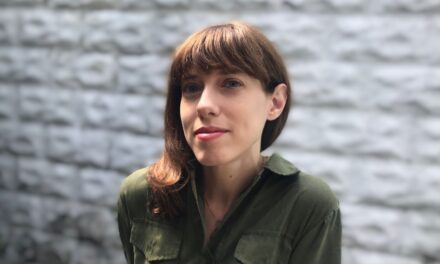Associate Editor James Ellenberger: Traci Brimhall’s “Heart Ghazal: An Essay” takes the signature move of the ghazal (the Radif, repetition) and gives it some room to breathe. This allows Traci to expand the (stetho)scope of the piece while still maintaining the Radif’s pounding inevitability. We get animal hearts and ghost hearts, hearts in their bodies and out, hearts in strife and hearts written in pen. Physical hearts butt up against symbolic representations of the heart, as if the two are vying for attention, as if the conflicts we live with are internal as well as external, physical as well as metaphysical. “Heart Ghazal: An Essay” grapples with the difficulty of accepting an external reality, the way things are, while we spend our days feeling around blindly in the dark of our bodies.
To hear Traci read her piece, you can click below:
“Heart Ghazal: An Essay”
by Traci Brimhall
They arrived, glistening pink against the black wax bottom of the stainless steel tray, ready to give beneath the pressure of our gloved fingers and the gentle violence of the scalpel. But before anyone could make the first cut, J—who earlier that semester stabbed my thigh with a pencil, who while driving me home one night would sell drugs to two guys at a Citgo station as I sat in the car and fidgeted with the locks—punched the cow’s heart.
The first one I ever held was like a butterfly made of meat. I hated its vulnerability but didn’t crush it, no, I held it in my hand and felt the last electrical flaps of that poor bass’s heart.
I used a fetal monitor to listen to my son’s whir, those rapid pulses—thundering hooves underwater. Now he listens to mine, reaching for the hem of my shirt, trying to see what he’s hearing, the hammer inside the shell of his ear not proof enough, though his first fact was the sound of my heart.
A researcher rinsed rat hearts with detergent until only translucent tissue was left and then injected the cardiac scaffolding with cells from a baby rat—eight days later it beat on its own. Before the resurrection, it looked like it could become anything, maybe even itself again, this de-created architecture, this ghost heart.
What remains unknown is the exact cause of my mother’s death, and unknown is how doctors mistook the pain of suffering for the pain of healing. Also unknown are her last words, and unknown is what birds sang as I pushed my son in his stroller, babbling his nonsense and the birds babbling theirs as my mom tried but couldn’t say, My heart, my heart.
Ectopia cordis is the condition where the sternum splits, arteries vine their way out of the chest, and that purple strawberry of a heart sits outside the body. There are names for when it beats on the wrong side of the ribs, when it’s too fast or too slow, though love is still what we call the consensual suffering of two hearts.
At the end of love, I woke up and couldn’t stand, laid in the bottom of the shower and cried, crawled out onto the lavender bath mat and cried, forced a brush through my hair, cried. I couldn’t even wish away the grief because it was all that was left, and when I pushed the pain around, I could shape it into a fist or a heart.
Experiments that study the living heart are called in vivo, and the study of dead hearts is ex vivo, and the study of either is a quatrain, and the results are published and served with ten ounces of Cabernet. I can’t remember the shape of his lower lip, but I remember Traci in his handwriting, and I remember he wrote, The people we love change who we are before he left, changed, signing his last letter with a heart.
Traci Brimhall is the author of Saudade (Copper Canyon, 2017), Our Lady of the Ruins (W.W. Norton, 2012), and Rookery (Southern Illinois University Press, 2010). She’s received a National Endowment for the Arts Literature Fellowship and is an Assistant Professor of Creative Writing at Kansas State University.
For more miCRo pieces, CLICK HERE.












